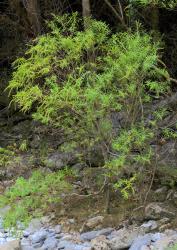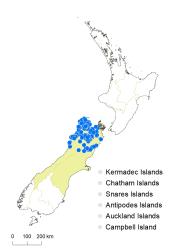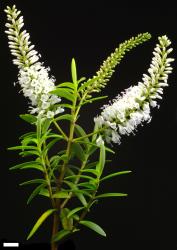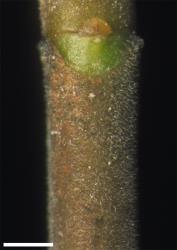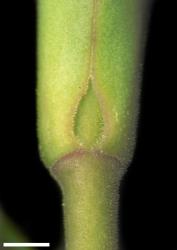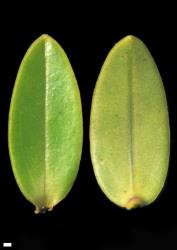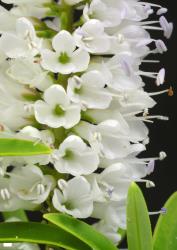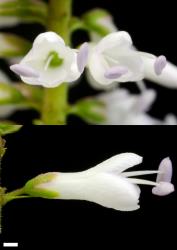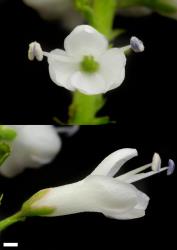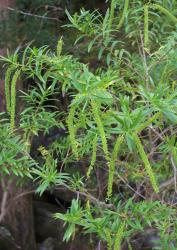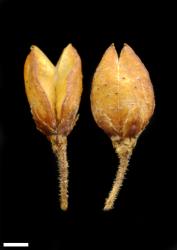- ≡ Hebe leiophylla (Cheeseman) Andersen, Trans. New Zealand Inst. 56: 693 (1926)
- ≡ Veronica parviflora var. phillyreaefolia Hook.f., Bot. Antarct. Voy. II. (Fl. Nov.-Zel.) Part I, 192 (1853)
- = Veronica ligustrifolia var. gracillima Kirk, Trans. New Zealand Inst. 28: 527 (1896)
- ≡ Veronica gracillima (Kirk) Cheeseman, Man. New Zealand Fl. 510 (1906)
- ≡ Hebe gracillima (Kirk) Cockayne & Allan, Trans. New Zealand Inst. 57: 24 (1926) – as Hebe ×gracillima
Bushy shrub to 3 m tall. Stems erect, eglandular-puberulent; hairs uniform. Leaf bud distinct, its leaves appressed at margins until fully grown; sinus acute, often very small. Leaves opposite-decussate or sub-distichous, erecto-patent to recurved; lamina thin to sub-coriaceous, linear to linear-lanceolate to oblong-elliptic, 8–56 mm long, 2.0–10.5 mm wide, dull to glossy, green above, green to pale green beneath; midrib and often two lateral veins evident; surfaces with eglandular hairs along midrib above and sometimes beneath, sometimes also with minute glandular hairs when young; margin ciliolate, entire; apex acute to obtuse, often with a short, blunt, plicate-acuminate tip; base abruptly cuneate; petiole 0.5–3.0 mm long. Inflorescence a lateral raceme, 35–165 mm long; flowers crowded,14–150, all bisexual; bracts alternate or sometimes loosely whorled, lanceolate to elliptic, < pedicels; pedicels erecto-patent, 0.9–3.0 mm long, pubescent all around, sometimes with very short glandular hairs as well. Calyx lobes 4, usually obtuse to sub-acute, rarely acute, 1.3–1.7 mm long, sub-equal, mixed glandular- and eglandular-ciliate to -ciliolate, sometimes hairy outside, especially near base. Corolla 4–8 mm diameter; tube white, 1.3–3.0 mm long, > to much > calyx, hairy inside and at throat; lobes 4, white or tinged pale purplish, sub-erect to erecto-patent, sub-equal, elliptic to ovate, 2.3–4.0 or rarely to 5.0 mm long, obtuse to rounded; nectar guides absent. Stamen filaments white, 4.5–7.5 mm long; anthers pink to purplish. Style usually glabrous or very rarely hairy, 4.7–8.0 mm long. Capsules latiseptate, sub-acute to obtuse, usually glabrous or very rarely eglandular-hairy, 2.7–5.0 mm long, 1.8–3.5 mm at widest point. Seeds discoid, flattened, smooth, pale brown, 1.2–1.7 mm long.
Veronica leiophylla is characterised by finely and very shortly puberulent stems, a small sinus in the vegetative buds, quite small leaves and long and slender inflorescences, a corolla with a long tube and often short, sub-erect lobes (similar to the corolla of V. stricta and similar species), and rather blunt and rounded capsules.
It is sometimes confused with V. phormiiphila, which is distinguished by longer, thinner, and more tapering leaves, shorter corolla tubes, and longer corolla lobes. Plants of V. leiophylla from the southern part of its range are not as distinct in these characteristics. This pattern and possible explanations for it were discussed by Bayly and Kellow (2006, under Hebe paludosa and H. leiophylla).
V. leiophylla plants have also sometimes been misidentified as V. subfulvida, which can be distinguished by shorter leaves, a more elongated sinus, branching inflorescences, and often bifarious stem hairs.
South Island: Western Nelson, Sounds Nelson, Marlborough, north Westland, North Canterbury.
In scrub and forest margins in a range of sites, sometimes swampy. Recorded elevations range from 0 to 1280 m.
The similarities with V. phormiiphila where the two species distributions abut are discussed above, and there is evidence to suggest V. phormiiphila might have originated as a hybrid between V. leiophylla and V. salicifolia (Bayly & Kellow 2006).
Flowers: December–April (sometimes to June); fruits: January–June (persisting all year).
2n = 80 (see Bayly & Kellow 2006, as Hebe leiophylla).
Veronica leiophylla is classified in V. subg. Pseudoveronica sect. Hebe and the informal group “Apertae” (small-leaved) (Albach & Meudt 2010; Bayly & Kellow 2006).
V. leiophylla is quite variable in a number of characters, including leaf size and shape (Bayly & Kellow 2006, Appendix 4), inflorescence length and number of flowers, indumentum of pedicels and calyx, and corolla tube and lobe length.
Bayly & Kellow (2006) recorded V. leiophylla as being cosexual, but a collection from Enchanted Quarry, Leatham Valley, Marlborough, included some male-sterile plants (B.P.J. Molloy, CHR 470117).



